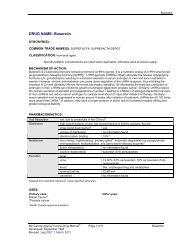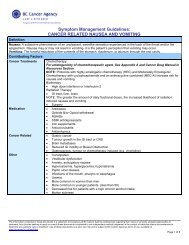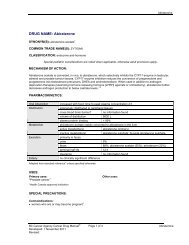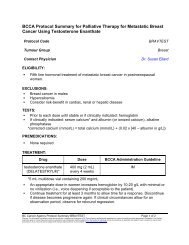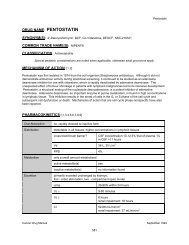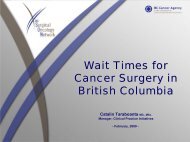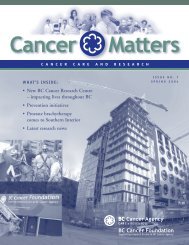Terry Fox Laboratory - BC Cancer Agency
Terry Fox Laboratory - BC Cancer Agency
Terry Fox Laboratory - BC Cancer Agency
Create successful ePaper yourself
Turn your PDF publications into a flip-book with our unique Google optimized e-Paper software.
Biennial Research Report 2005 ‐2006T ERRY F OX L ABORATORYB C C A CANCER RESEARCH CENTRE675 West 10th Avenue, Vancouver, <strong>BC</strong>Tel: 604‐675‐8120Our Research Focus:The <strong>Terry</strong> <strong>Fox</strong> <strong>Laboratory</strong> (TFL) was created in 1981 as a joint undertaking between the <strong>BC</strong><strong>Cancer</strong> <strong>Agency</strong>, the <strong>BC</strong> <strong>Cancer</strong> Foundation, the University of British Columbia and the National<strong>Cancer</strong> Institute of Canada. By the end of 2005, TFL had grown to comprise a group of over 150researchers, including a vibrant training program involving 42 undergraduate students, 33graduate students and 27 postdoctoral (MD and PhD) fellows. The TFL also includes a FlowCytometry Core Facility that services the needs of investigators throughout the <strong>BC</strong>CA as well asthe Stem Cell Service, a specialized provincial clinical support program in hematology andoncology. The Stem Cell Service provides the laboratory support for the Leukemia/Bone MarrowTransplantation Program of <strong>BC</strong> and also an investigational diagnostic laboratory forhematologists and oncologists throughout <strong>BC</strong>.TERRY FOX LABORATORYTFL research is focused on obtaining solutions to biological questions and problems that willlead to major advances in the diagnosis and treatment of human cancers. These include thedevelopment of a broad spectrum of approaches, new systems and experimental models, and theuse of primary human samples as well as cells and animals to elucidate the cellular andmolecular perturbations that confer malignant potential on cells and to devise more effectivemethods for eliminating malignant cells. In 2005‐2006, specific tumour types being investigatedincluded acute and chronic myeloid leukemia and the myelodysplastic disorders, lymphoma andbreast cancer.Progress Highlights during 2005 and 2006‣ The discovery that the protein SHIP controls the activity of macrophages so that they do notoverreact in response to bacterial and viral attacks. This knowledge is being used to developnew strategies to treat allergies, auto‐immune disorders and to control septic shock inhospital patients.‣ The discovery of a novel pathway by which natural killer cells with previously unknownproperties can develop in both the thymus and lymph nodes.‣ The discovery of how a large class of natural killer receptor genes important for innateimmunity and tumour defense are controlled by epigenetic changes to DNA (DNAmethylation and histone modifications).‣ The discovery that mutations in the telomerase gene are a common cause of bone marrowfailure in humans who inherit a predisposition to this disease.‣ The discovery that more than half of all children with T‐cell acute lymphoblastic leukemiashare a mutation in a Notch gene leading to activation of myc.‣ The discovery of a new gene (TGIF) that modulates the rate of fibroblast cell proliferation.149
British Columbia <strong>Cancer</strong> <strong>Agency</strong>TERRY FOX LABORATORY‣ The discovery of rapidly dividing stem cells in the normal breast that can individuallyregenerate an entire mammary gland and have features shared by bad prognosis breastcancer.‣ The discovery that blood‐forming stem cells undergo an abrupt developmental switch soonafter birth that causes most of them to suddenly stop dividing.‣ The discovery of a new agent for killing human acute leukemia cells that may be moreeffective in patients‣ The discovery of how several different pairs of genes and mutations may collaborate to causeleukemia.Key Research StaffResearcher nameAllen EavesMD, PhD MedicalBiophysics, FRCPC, FACPPosition & Cross‐AppointmentsDirectorProfessor, Medicine, U<strong>BC</strong>Professor, Pathology & <strong>Laboratory</strong> Medicine, U<strong>BC</strong>Ryan Brinkman PhD Genetics Senior ScientistAssistant Professor, Medical Genetics, U<strong>BC</strong>Connie Eaves PhD Immunology Director (Starting January 1, 2007)Professor, Medical Genetics, U<strong>BC</strong>Associate Member, Medicine, U<strong>BC</strong>Associate Member, Pathology & <strong>Laboratory</strong>Medicine, U<strong>BC</strong>Member, Exp Medicine, Exp Pathology, GeneticsProgram, Oncology Program, U<strong>BC</strong>Donna Hogge MD, PhD ExperimentalPathology, FRCPCSenior ScientistClinical Professor, Medicine, U<strong>BC</strong>Sr Hematologist Leukemia/BMT Program of <strong>BC</strong>Member, Exp Medicine, Genetics Program, OncologyProgram, U<strong>BC</strong>Pamela Hoodless PhD Biochemistry Senior ScientistAssistant Professor, Medical Genetics, U<strong>BC</strong>Member, Genetics Program, Oncology Program, U<strong>BC</strong>Keith Humphries MD, PhD Medical Genetics Senior ScientistProfessor, Medicine, U<strong>BC</strong>Associate Member, Medical Genetics, U<strong>BC</strong>Member, Exp Medicine, Exp Pathology, GeneticsProgram, Oncology Program, U<strong>BC</strong>Xiaoyan Jiang MD, PhD MolecularBiologyResearch ScientistAssistant Professor, Medical Genetics, U<strong>BC</strong>Professor, Medical Genetics, U<strong>BC</strong>Member, Genetics Program, U<strong>BC</strong>Gerald Krystal PhD Biochemistry Senior ScientistProfessor, Pathology and <strong>Laboratory</strong> Medicine, U<strong>BC</strong>Member, Exp Medicine, Exp Pathology, U<strong>BC</strong>Member, Genetics Program, Oncology Program, U<strong>BC</strong>150
Biennial Research Report 2005 ‐2006Peter Lansdorp MD, PhD ExperimentalHematologySenior ScientistDirector, Flow Cytometry Core, <strong>BC</strong>CAProfessor, Medicine, U<strong>BC</strong>Associate Member, Medical Genetics, U<strong>BC</strong>Member, Genetics Program, Oncology Program, U<strong>BC</strong>Dixie Mager PhD Medical Biophysics Senior ScientistProfessor, Medical Genetics, U<strong>BC</strong>Member, Genetics Program, Oncology Program, U<strong>BC</strong>Clayton Smith MD, FRCPC Senior ScientistClinical Associate Professor, Medicine, U<strong>BC</strong>Director, Leukemia/Bone Marrow TransplantationProgram of <strong>BC</strong>Fumio Takei PhD Immunology Senior ScientistAndrew WengMD, PhD MolecularGenetics and Cell BiologyProfessor, Pathology and <strong>Laboratory</strong> Medicine, U<strong>BC</strong>Associate Member, Medical GeneticsMember, Exp Pathology, Genetics Program,Oncology Program, U<strong>BC</strong>Senior ScientistClinical Scientist, Pathology, <strong>BC</strong>CAAssistant Professor, Pathology & <strong>Laboratory</strong>Medicine, U<strong>BC</strong>Member, Oncology Program, U<strong>BC</strong>TERRY FOX LABORATORYTrainingA) Course InstructionR Brinkman U<strong>BC</strong> MEDG 420 R Kay MEDG 420R Brinkman U<strong>BC</strong> MEDG 548C R Kay MEDG 521C Eaves U<strong>BC</strong> MEDG 548C G Krystal U<strong>BC</strong> Path 500AD Hogge U<strong>BC</strong> Medicine II: Blood & G Krystal MEDG 521Lymphatics G Krystal MEDG 410D Hogge U<strong>BC</strong> Pathology 548R G Krystal PATH 402P Hoodless U<strong>BC</strong> MEDG 545 G Krystal U<strong>BC</strong>Immunology 431: <strong>BC</strong>CA MedOncol ResidentsP Hoodless U<strong>BC</strong> MEDG 521/ PATH 531 P Lansdorp U<strong>BC</strong> Med Gen 521P Hoodless U<strong>BC</strong> MEDG 515 D Mager U<strong>BC</strong> MEDG 545K Humphries U<strong>BC</strong> Pathology 500 D Mager U<strong>BC</strong> MEDG 420K Humphries Stem Cell Directed Studies Seminar D Mager U<strong>BC</strong> MEDG 530X Jiang U<strong>BC</strong> FMED 428 F Takei U<strong>BC</strong> Oncology 502R Kay U<strong>BC</strong> MEDG 545B) Summary of TraineesTotal No. of Post‐doctoral Post‐graduate Undergraduate ClinicalTrainees2005 102 27 33 42 02006 100 33 41 26 0151
British Columbia <strong>Cancer</strong> <strong>Agency</strong>TERRY FOX LABORATORYC) Current Students – Degrees CompletedName Supervisor Date CompletedPhDMichelle Bowie C Eaves 2006Brad Dykstra C Eaves 2006Lynn Mar P Hoodless 2006Rhonna Gurevich K Humphries 2005Nadine Beaulieu R Kay 2006Iris Cheung P Lansdorp 2005Louie Van de Lagemaat D Mager 2006Linnea Veinotte F Takei 2006MScAndrea Tegzes C Eaves 2006Sanja Sekulovic K Humphries 2005Lisa Dreolini F Takei 2005Matt McLeod F Takei 2006D) Trainee AwardsName Supervisor Award ReceivedMichelle Bowie C Eaves CIHR Transplant Partial Studentship (2003‐2006)Christina Chan C Eaves NSERC Industry Graduate Studentship (2006‐2007)Michael Copley C Eaves U<strong>BC</strong> Graduate Entrance Studentship (2006‐2007)Brad Dykstra C Eaves NCIC TTF Research Studentship (2003‐2008)Peter EirewC Eaves Stem Cell Network Graduate Studentship (2006)NCIC Graduate Studentship (2006‐2007)CI<strong>BC</strong> Interdisciplinary Graduate Studentship (2006‐2007)Department of Defense Breast <strong>Cancer</strong> Program ‐Post GraduateAward (2006‐2009)Clive Glover C Eaves CIHR Doctoral Research Award (2004‐2007)Melanie Kardel C Eaves NSERC Graduate Fellowship (2004‐2005)CIHR Canada Graduate Studentship (2005‐2008)MSFHR Studentship (2005)Sean Kennedy C Eaves NSERC Studentship (2003‐2005)David KentC Eaves Stem Cell Network Graduate Studentship (2004‐2006)U<strong>BC</strong>/MSFHR/CIHR Transplant Partial Studentship (2005‐2007)CIHR Doctoral Research Award (2006‐2009)Min Lu C Eaves Industrial NSERC Postdoctoral Fellowship (2006‐2007)Kai Lucke C Eaves German Government Postdoctoral Fellowship (2004‐2006)Michael O’Connor C Eaves CIHR Industry‐Partnered Postdoctoral Fellowship (2006‐2009)Afshin Raouf C Eaves CIHR Postdoctoral Fellowship (2004‐2007)Andrea Tegzes C Eaves NSERC Industrial Studentship (2004‐2006)Yun Zhao C Eaves Leukemia Research Fund Postdoctoral Fellowship (2004‐2007)Andrew Muranyi D Hogge U<strong>BC</strong> Graduate Studentship (2004‐2005)Robin Dickinson P Hoodless MSFHR Postdoctoral Fellowship (2005)Ali Saleem Hassan P Hoodless U<strong>BC</strong> Graduate Entrance Studentship (2006‐2007)Sam Lee P Hoodless U<strong>BC</strong> Graduate Entrance Studentship (2006‐2007)Kristen McKnight P Hoodless NSERC Studentship (2004‐2007)Pavie Vrljicak P Hoodless U<strong>BC</strong> Graduate Entrance Studentship (2004‐2006)Bob Argiropoulos K Humphries Leukemia Research Fund Postdoctoral Fellowship (2006‐2008)152
Biennial Research Report 2005 ‐2006Michael Heuser K Humphries Deutsche Forschungsgemeinschaft Fellowship (2005‐2007)Koichi Hirose K Humphries MSFHR Postdoctoral Fellowship (2003‐2005)Florian Kuchenbauer K Humphries Deutsche Forschungsgemeinschaft Fellowship (2005‐2007)Eric YungK Humphries MSFHR Fellowship (2005)Frann Antignano G KrystalCIHR Fellowship (2005 ‐ 2008)NSERC Studentship (2003 ‐ 2006)Melisa Hamilton G KrystalMSFHR Junior Graduate Studentship (2004‐2006)MSFHR Studentship (2006 2008)CIHR Canada Graduate Scholarship – Master’s Award(20062007)Victor Ho G Krystal NSERC Studentship (2006 ‐ 2007)Michael Rauh G Krystal/ AW CIHR MD/PhD Studentship (2000 ‐ 2007)ChowIris Cheung P Lansdorp CIHR Canada Graduate Studentship (2003‐2005)Michelle Decker P Lansdorp MSFHR Studentship (2006‐2007)Matthew Greenwood P Lansdorp Stem Cell Network Graduate Studentship (2003‐2005)Irina Maksakova D Mager Roman Babicki Studentship (2005‐2006)U<strong>BC</strong> Graduate Studentship (2006‐2007)Dafni Reiss D Mager Multiple Sclerosis Society of Canada Fellowship (2006‐2008)Mark Romanish D Mager Harry and Florence Dennison Fellowship in Medical Research(2006‐2007)Arefeh RouhiD MagerEdward Squires Memorial Scholarship (2004‐2005)NSERC Studentship (2003‐2005)MSFHR Studentship (2006)Louie Van De D Mager CIHR Doctoral Research Award (2004‐2006)LagemaatValeria Alcon F Takei Leukemia Research Postdoctoral Fellowship (2006‐2008)Eva Backstrom F Takei Swedish Research Council & Leukemia Research FundPostdoctoral Fellowships (2005‐2008)Lisa Dreolini F Takei NSERC Studentship (2003 – 2005)Motoi Maeda F Takei Leukemia Research Foundation (2003‐2005)Linnea Veinotte F Takei MSFHR Studentship (2004‐2005)TERRY FOX LABORATORYCurrent Awards and HonoursNameC EavesDistinguished Award/Honour<strong>Terry</strong> <strong>Fox</strong> Medal of the <strong>BC</strong> Medical Society (2005)Till and McCulloch Lecturer of the Stem Cell Network (2006)R Brinkman ISAC Scholar, International Society for Analytical Cytometry (2006)P Hoodless CIHR New Investigator Scholar Award (2003‐2008)X Jiang MSFHR Scholar Award (2005)C Smith MSFHR Scholar Award (2003‐2008)A WengBenjamin Castleman Award, U. S. & Canadian Academy of Pathology (2005)United Food & Commercial Workers Union Award (Highest rated operatinggrant for 2006 funding cycle, Leukemia & Lymphoma Society of Canada)MSFHR Scholar Award (2005)153
British Columbia <strong>Cancer</strong> <strong>Agency</strong>TERRY FOX LABORATORYSelect Current ContributionsNameAllen EavesRyan BrinkmanConnie EavesDonna HoggePamela HoodlessKeith HumphriesXiaoyan JiangRobert KayGerald KrystalPeter LansdorpDixie MagerClayton SmithFumio TakeiMembership/Committee InvolvementDirector, Stem Cell ServiceChair, MITACS Board of DirectorsMember, Board of Directors of the Stem Cell NetworkMember, Int’l Society for Analytical Cytometry Data Standards Task ForceMember, MSFHR Junior Graduate Scholarship Review CommitteeChairman & Supervisor, Management Committee of Joint Animal Facility, <strong>BC</strong>CAChair, NCIC Hematopoiesis & Growth Factors Review PanelAssociate Scientific Director, Stem Cell Network of CanadaMember, Board of Genome CanadaMember, 2005 Amer Assoc for <strong>Cancer</strong> Research Program CommitteeMember Int Society of Experimental Hematology Awards CommitteeDirector, Cryogenic <strong>Laboratory</strong>, Stem Cell ServiceChair, MSFHR Senior Graduate Trainee Awards CommitteeChair, MSFHR Post Doctoral Fellowship Trainee Awards CommitteeAlberta <strong>Cancer</strong> Board Research Initiative Program Grant CompetitionChair, Canadian Council of American Society for Gene TherapyDirector, Transgenic and Gene Targeting Facility, <strong>BC</strong>CAAssociate Editor, Experimental HematologyMember, Leukemia Research Fund of Canada Scientific Review PanelMember, External Advisory Board Center (to establish a Center for non‐embryonichuman stem cells) for Stem Cell and Regenerative Medicine, Case WesternUniversity, Cleveland, OHMember, CIHR Developmental Biology Grants CommitteeMember, Steering Committee of the Canada‐California Strategic InnovationPartnership on <strong>Cancer</strong> Stem CellsElected Vice‐President, President‐Elect and President, International Society forExperimental HematologyPanel Member, MSFHR Biomedical Postdoc Fellowship Review CommitteeNIH‐NHLBI Peer Review Panel Member, Special Emphasis Panel forMyelodysplastic Syndrome (RFA HL‐04‐033) and Myeloproliferative Disorders(RFA HL‐04‐034) Columbia, MDMember, Medical Genetics Graduate Program Advisory CommitteeMember, Genetics Graduate Program Advisory CommitteeMember, Pathology & <strong>Laboratory</strong> Medicine Promotions Committee, U<strong>BC</strong>Member, U<strong>BC</strong> Faculty of Medicine Nominating CommitteeMember, CIHR Genetics Review PanelMember, Board of Directors, National <strong>Cancer</strong> Institute of CanadaMember, American Society of Hematology Scientific Committee on Stem CellsAdvisory Board Member, International Society of Stem Cell ResearchSpecial Emphasis Panel, NHLBI, Washington DCMember, Radiation Safety Committee, <strong>BC</strong>CAMember, MEDG Teaching Award CommitteeMember, Planning Committee for Genetics Graduate Program, U<strong>BC</strong>Member, MSFHR Studentship Review CommitteeMember, CIHR Genetics Review PanelMember, <strong>BC</strong> <strong>Cancer</strong> <strong>Agency</strong> Tumour Site Leadership CouncilMember, International Society of Cellular Therapy Advisory BoardMember, NCIC Immunology Grants Panel154
Biennial Research Report 2005 ‐2006Current Research Projects 31. Activation and proliferation of purified hemopoietic stem cellsPI: P LansdorpNIH$187,500 (2005)$187,500 (2006)$595,758 (2002‐2007)This project examines the role of telomerase and telomeres incontrolling blood cell production throughout life. This projectwill test the hypothesis that the replication history ofhematopoietic stem cells is traceable by examining telomerelength.2. A phase I study of DT388IL3 fusion protein in patients with relapsed and refractory acute myeloidleukemiaPI: D HoggeLeukemia Research Fund of Canada$43,500 (2005)$43,500 (2006)$87,000 (2004‐2006)The goal of this study is to assess dosage and toxicity of asterilized recombinant diphtheria fusion protein – DT388IL3 – ina clinical trial of patients with acute myeloid leukemia.TERRY FOX LABORATORY3. A novel transplant protocol for chronic myelogenous leukemiaPI: A Eaves, C Eaves, M de Lima(MD Anderson)NIH$67,500 (2005)$132,500 (2004‐2006)This project will evaluate three purging methods to selectivelyeliminate chronic myelogenous leukemia stem cells ex vivo.4. A quantitative and comprehensive atlas of gene expression in mouse development ‐ GenomeCanada Competition II awardCo‐PI: M Marra, P HoodlessGenome Canada5. Bioinformatic standards for flow cytometryPI: R BrinkmanCo‐PI: C SmithNIH$220,000 (2005)$220,000 (2006)$1,100,000 (2005‐2010)For project description see Genome Sciences CentreThis project is a multidisciplinary collaboration focused ondeveloping data exchange standards for flow cytometry. Thescope of this project includes development of an ontology, a database schema, statistical and visual analysis tools, and a gatingstandard in the Extensible Markup Language (XML).6. Biology of cancer: Follicular lymphoma as a model of cancer progressionPI: J ConnorsCo‐I: A WengNCIC PPG7. <strong>Cancer</strong> Genomics – Genome Canada Competition I awardCo‐PI: V Ling, M Marra, C EavesCo‐I: K Humphries, P Lansdorp, etal.Genome Canada/ Province of <strong>BC</strong>For project description see Pathology and <strong>Laboratory</strong> Medicine.For project description see <strong>Cancer</strong> Genetics & DevelopmentalBiology.3 Key to abbreviations: PI = Principal Investigator, Co‐I = Co‐investigator; CIHR* = Funding Institution; $150,000 (2005‐2007) = Total Project Funding for Given Years (*see pages 16‐17 for a list of acronyms)155
British Columbia <strong>Cancer</strong> <strong>Agency</strong>TERRY FOX LABORATORY8. Cell therapy for muscular diseasePI: F Rossi (U<strong>BC</strong>)Co‐PI: K HumphriesStem Cell NetworkTotal to KH ‐ $96,000 (2005‐2008)9. Characterization of anti‐tumour activity of STEP‐1PI: C LuerCo‐PI: C SmithNIHTotal to CS ‐ $11,700 (2005‐2007)10. CIHR team grant in cell expansionPI: G Sauvageau (UMontreal)Co‐I: K Humphries, C EavesCIHR team grant$198,233 (2006)$1,000,000 (2006‐2011)The goal is to promote generation of hematopoietic stem cellsfrom murine embryonic stem cells.This project will characterize the activity of an apoptosis inducingfactor found in a natural extract using high throughput flowcytometric screening.The major goals are: 1) To gain a better understanding of howHox‐related genes regulate hematopoietic stem cell self‐renewaland 2) to use this information to evaluate the potential ofmanipulating Hox levels in patients’ stem cells to expand theirnumbers and improve transplantation‐based therapies wherestem cell numbers are limiting.11. Dependence of human embryonic stem cell self‐renewal on culture variablesPI: C EavesStem Cell Network$34,958 (2005)$323,600 (2003‐2005)The goal is to study how varying the environment under whichcells are grown will change the expression of different genes tobetter control stem cell growth and differentiation.12. Development of technologies for the derivation, propagation and differentiation of humanembryonic stem cells (HESC)PI: J. Piret (U<strong>BC</strong>), C Eaves, MBhatia, A NagyCo‐I:, K Humphries, P Lansdorp, AKarsan, M Marra, et alStem Cell Network$157,557 (2005)$157,557 (2006)This project will lay the groundwork for developing humanembryonic stem cell‐based therapies and facilitate the broader useof these cells to identify new drugs that stimulate or repressparticular regenerative events in vivo.13. Diagnosis of graft versus host disease using high throughput flow cytometeryPI: C Smith<strong>BC</strong> Transplant Foundation$30,000 (2006)$90,000 (2006‐2008)The goal is to analyze a previously collected data set comprised ofhigh throughput flow data obtained from peripheral bloodsamples at progressive time points following allogeneictransplantation to identify flow cytometric signatures of GvHD.14. Disease mechanisms in chronic myeloid lymphoma (CML)PI: A EavesCo‐PIs: C Eaves, X JiangNCIC$150,000 (2005)$150,000 (2006)$705,000 (2003‐2011)The goal is to study CML stem cells, since controlling or destroyingthese cells is necessary if CML is to be cured. We will look at howthe speed of CML cell multiplication is controlled; what are theproperties of these cells that cause leukemia to relapse; andwhether a mouse xenografting model can be used to predict theutility of new drugs for this disease.156
Biennial Research Report 2005 ‐200615. Dissecting gene expression networks in mammalian organogenesisCo‐PIs: P Hoodless, M MarraCo‐I: A Karsan, C Helgason, SJones, S Katz (U<strong>BC</strong>), E Levy(U<strong>BC</strong>)Genome Canada Comp. III /Genome<strong>BC</strong>$224,543 (2006)$4,787,197 (2006‐2008)16. Downstream targets of Notch in lymphoid neoplasiaPI: A WengLLSC$52,500 (2006)$105,000 (2006‐2008)17. Downstream targets of Notch signaling in lymphoid neoplasiaPI: A WengLLSC$60,000 (2006)$180,000 (2006‐2008)18. Effects of retroelements on mammalian genesPI: D MagerCIHR$142,969 (2005)$142,969 (2006)$719,930 (2004‐2009)The goal is to focus on the development of three organs in themouse embryo, the heart, pancreas, and the liver. In particular, thefocus is on the tissues in the heart involved in valve formation andseparation of the chambers, in the pancreas on the formation ofislet cells, and in the liver on hepatocytes.The goals are to 1) characterize c‐Myc as a Notch target gene and to2) identify and characterize additional Notch target genes in apanel of established human tumour cell lines.The major goals are 1) to characterize c‐Myc as a Notch target geneand 2) to identify and characterize additional target genes in apanel of established human tumour cell lines.The goal is to understand how mobile genetic elements (“jumpingDNA”) in human and mouse genomes affect the expression andrearrangement of genes. This project will also examine the role thatmobile elements may play in determining the qualities thatdistinguish humans from our closest relative, the chimpanzee.TERRY FOX LABORATORY19. Gene therapy for sickle cell anemia and β‐thalassemia (Gene transfer and stem cell biology in sicklecell disease and supplement)Co‐PI: C Eaves, K HumphriesNHLBI/ NIHUS$437,272 (2005)US$62,290 (2006)$2,186,360 (2000‐2005)20. HOXB4 is an activator of HSC self‐renewalPI: K Humphries, G Sauvageau (UMontreal)NIH$122,962 (2005)$122,962 (2006)$416,000 (2005‐2009)21. HOXB4 target‐genes specifying hematopoietic stem cell renewalPI: K HumphriesStem Cell Network$74,899 (2005)$396,846 (2003‐2005)The goal is successful preclinical development of a gene therapyprotocol for treating patients with sickle cell disease (SCD).The goals are to 1) enhance the potential of HSCs to expand invitro, 2) develop and test clinically‐relevant strategies aimed atachieving a maximal expansion of HSCs in vitro, 3) identify aHOXB4‐containing “HSC‐renewal protein complex” and 4)determine the role of the newly identified proteins in HSC selfrenewal.This project will determine the target genes of specific transcriptionfactor is in rare cell types with the goal of identifying key transcriptsubsets that correlate with enhanced HSC self‐renewal capacity.157
British Columbia <strong>Cancer</strong> <strong>Agency</strong>TERRY FOX LABORATORY22. Integrated linked kinase as a therapeutic target in acute myeloid leukemiaPIs: D HoggeLLSC$50,000 (2005)$50,000 (2006)$150,000 (2006‐2008)We will test the possibility that abnormal activation of anintracellular signaling molecule, integrin linked kinase or ILK, iscritical to the survival of AML cells including those malignant‘stem cells’ that allow long‐term growth leukemia in mice and thatinhibition of ILK will result in the death of AML cells whilesparing most normal cells.23. Investigation of the roles of new genes selectively expressed in primitive human mammaryepithelial cellsPI: C EavesC<strong>BC</strong>F <strong>BC</strong>/Yukon Chapter$50,000 (2006)$150,000 (2006‐2008)The goals are to compare the expression of certain genes inprimitive normal human mammary cells their mature progeny, tofollow these changes during the differentiation of the primitivecells in cultures and to test how they may regulate this process.24. Manipulation of proliferative abnormalities in acute myeloid leukemia (AML) stem cellsPI: D Hogge<strong>Cancer</strong> Research Society$57,000 (2005)$114,000 (2003‐2005)The goal is to characterize the molecular basis of proliferativeabnormalities in AML cells in order to facilitate the identificationof targets for novel therapeutic agents.25. Modeling transcriptional networks during cardiac cushion developmentPI: A KarsanCo‐PI: P HoodlessCIHR$10,000 (2005) to PH.$2,391,13 (2005‐2010)The overarching objective of this program is to elucidate thetranscriptional program of this critical region of the heart (theendocardial cushions) in human tissues, and generate andvalidate a detailed model of this developmental process.26. Molecular characterization of AHI‐1, a novel signaling molecule with a SH3 and multiple WD40‐repeat domains, in normal and leukemic hematopoiesisPI: X JiangMSFHR Estab. Grant$75,000 (2005)$75,000 (2006)$225,000 (2005‐2007)The goal is to characterize the functions of Ahi‐1 in regulatingnormal hematopoietic stem cell proliferation and differentiationusing a conditional knockout model system, and to identify andcharacterize molecular partners involved in normal and alteredsignaling pathways regulated by Ahi‐1 using a new proteomicsapproach (IP+MS).27. Molecular biology of the initiation of T‐cell transformation by RasGRP1 and Ras GTPasesPI: R Kay<strong>Cancer</strong> Research Society$60,000 (2005)$60,000 (2006)$240,000 (2004‐2008)This project will use a murine model to investigate mechanisticlinks between normal and malignant development of T‐cells and toidentify activating mutations in Ras GTPases that frequently occurin T‐cell acute lymphoblastic leukemia28. NK and NKT in Herpes simplex virus Type 1 (HSV 1) infection in micePI: L Kastrukoff (U<strong>BC</strong>)Co‐PI: F TakeiCIHR$78,720 (2005)$78,720 (2006)$393,600 (2005‐2008)Resistance to Herpes simplex virus (HSV) infection, which causesmultiple sclerosis‐like syndrome in mice, is regulated by a genecluster encoding multiple receptors on natural killer (NK) cells.The goal of this project is to determine the role of NK cells inimmune response to Herpes simplex virus and to identify thegenes and the receptors responsible for the resistance to HSVinfection.158
Biennial Research Report 2005 ‐200629. NK cell differentiationPI: F TakeiCIHR$128,027 (2005)$128,027 (2006) $320,068(2003‐2007)30. Normal and leukemic hematopoiesisPI: K HumphriesCo‐Is: C Eaves, P Hoodless,Krystal, P LansdorpNCIC Group Grant$5,238,379 (2002‐2007)GThe goal of this study is to compare the generation of NK cellsfrom primitive blood‐forming cells in newborn and adult mice todetermine why this process takes a long time.The overall goal of this program is to determine how normal bloodcells become leukemia cells and to apply that information todevelop new leukemia treatments.This program is comprised of the following sub‐projects:TERRY FOX LABORATORY31. Notch signaling in lymphoid neoplasiaPI: A WengMSFHR Estab. Grant & CareerDev. Award$62,500 (2006)$377,500 (2006‐2011)32. Notch signaling in lymphoid neoplasiaPI: A WengNCI Career Development AwardCharacterization and self‐renewal control of normalhematopoietic stem cellsPI: C Eaves $191,400 (2005) $191,400 (2006)The long‐term goal of this project is to develop methods forcontrolling and manipulating normal hematopoietic stem cell(HSC) expansion.Genetic determinants of hematopoietic stem cell functionPI: K Humphries $171,535 (2005) $171,535 (2006)The major goals of this project are to discover and elucidate theroles/mechanisms of novel Hox and related molecules in normaland leukemic hemopoiesis.Regulation of proliferation vs differentiation during normal andleukemic hemopoiesis.PI: G Krystal $127,045 (2005) $126,166 (2006)The major goals of this project are to understand the effects of theTFGβ and PI3K pathways on normal and abnormal hemopoieticcells.Telomere length regulation in murine cellsPI: P Lansdorp $173,585 (2005) $175,610 (2006)The goal of this project is to understand telomere lengthregulation in the mouse and clarify the relation between telomerelength and telomere function.TGFβ signal transduction pathways in developmental programsPI: P Hoodless $149,250 (2005) $149,250 (2006)This project examined the role of the transcriptional repressor,TGIF, in embryogenesis, cell cycle and signaling in the mouse.The major goals are to characterize Notch target genes inestablished human tumour cell lines, and to score these targetgenes for leukemogenic potential in animal models; also, tocharacterize promoter elements upstream of candidate Notchtarget genes.For project description see Pathology and <strong>Laboratory</strong> Medicine.159
British Columbia <strong>Cancer</strong> <strong>Agency</strong>TERRY FOX LABORATORY33. Novel agents for hematopoietic stem cell expansionPI: K HumphriesCIHR POP$136,018 (2005)$136,018 (2005‐2005)The proposed work will investigate the effectiveness of novel stemcell expanding reagents and to develop them into reagents that canbe safely and efficiently used clinically.34. Optimization of the use of diphtheria toxin‐growth factor fusion proteins for the treatment of acuteleukemiaPI: D HoggeCIHR$22,918 (2005)$22,918 (2006)$68,754 (2004‐2006)The goal is to measure the level of expression of the targetreceptors on different leukemia samples and the proliferativeactivity the leukemia cells from these samples to determine if thesefeatures predict response to the DT‐GF molecules. We will alsodetermine if combining the DT‐GF molecule with another drugwhich targets leukemia cells will be more effective than either drugalone.35. Optimization of the use of diphtheria toxin‐growth factor fusion proteins for the treatment of acuteleukemiaPI: D HoggeNCIC$116,179 (2005)$116,179 (2006)$350,000 (2005‐2008)This project is investigating a different class of targeting moleculesin which the diphtheria toxin (DT) is fused to a growth factor (GF)molecule to target leukemic cells. The proposed studies willfacilitate the entry of new and improved molecules and patientselection strategies into clinical trials which may ultimatelyimprove anti‐leukemic therapy for patients with Acute MyeloidLeukemia.36. Receptors on NK and NKT cellsPI: F TakeiNCIC$145,368 (2005)$145,368 (2006)$735,438(2003‐2008)This goal is to study NKT cells in more detail. In particular, we willfind out what role NKT cells have in the immune system, whetherthey use the same receptors as NK cells to recognize healthy cells,and what factors stimulate their activity.37. Regulation of natural killer cell receptor genesPI: D MagerCIHR$127,700 (2005)$127,700 (2006)$638,500 (2004‐2009)38. Replicative shortening of telomeres in human cellsPI: P LansdorpCIHR$132,069 (2005)$132,069 (2006)$660,345 (2005‐2010)The goal is to elucidate the mechanisms that generate functionaldiversity of NK cells – the white blood cells considered to be thefirst line of immune defense against virus‐infected and cancer cells.The focus is on the receptors on NK cells that recognize MHCclass‐I molecules, and to employ the development of new ways toharness the body’s immune system to eliminate cancer cells.The goal is to investigate the role of the human RTEL (regulator oftelomere length) protein in the growth of normal and malignantcells. The objective of this study is to understand the role oftelomeres in aging and cancer by addressing specific questionsabout the molecular mechanisms of telomere loss.160
Biennial Research Report 2005 ‐200639. Role of DNA methylation in controlling syncytin: a novel gene implicated in multiple sclerosisPI: D MagerMultiple Sclerosis Society$35,000 (2005)$35,000 (2006)$70,000 (2005‐2006)40. Role of LFA‐1 in cell mediated cytotoxicityPI: F TakeiCIHR$58,632 (2005)$58,632 (2006)$586,315 (2005‐2010)41. Role of RasGRP1 in <strong>BC</strong>R‐induced deletion of immature B cellsPI: R KayCIHR$117,336 (2005)$117,336 (2006)$821,347 (2004‐2008)This project will investigate if the ERV transcriptional promoter ofthe syncytin gene is a sensitive target for epigenetic regulation andthat perturbations in this regulation may be involved in multiplesclerosis.The goal of this study is to understand how a protein called LFA‐1involved in cell‐cell binding acts to initiate the cascade of events toguide ‘killer lymphoctye’ cells of the immune system to attackdiseased cells.The goal is to understand the molecular mechanism by which RasGRP1 increases the sensitivity of immature B cells to survivalsignal suppression and induction of cell death. Insight intoregulation of B cell activation vs. deletion is critical to ensureeffective immune response to foreign antigens while avoidingauto‐immunity.TERRY FOX LABORATORY42. Role of retroelements in age related gene expressionPI: D MagerCIHR (Pilot Project)$49,942 (2005)$49,942 (2006)$100,000 (2006‐2007)43. Stem cell and gene regulationPI: A EavesCo‐PIs: C Eaves, D Hogge, PHoodless, K Humphries, RKay, G Krystal, P Lansdorp, DMager, C Smith, HSutherland, F TakeiMSFHR Research Unit$250,000 (2005)$250,000 (2006)$1,000,000 (2003‐2008)44. Stem cell centrePI: P LansdorpCFI$1,008,384 (2005)$1,008,384 (2006)$3,775,195 (2002‐2005)45. Stem cell centre ‐ infrastructure operating fundsPI: P LansdorpCFI$110,079 / yr (2005, 2006)$231,346 (2003‐2006)This project will investigate whether the gradual, age‐relateddemethylation of retroelements, located within or near genes canlead to altered expression of genes.This goal is to enhance studies to understand the molecularpathways that govern stem cell renewal, viability, theirdevelopment into specific types of cells, their ability to multiplyand their genome stability.This project will address new questions in stem cell biology andexplore emerging possibilities for the use of stem cells inregenerative medicine. The centre will comprise of threelaboratories: a stem cell sorting and analysis laboratory, a genevector laboratory and a Good Manufacturing Practice (GMP) StemCell Processing <strong>Laboratory</strong>.Partial infrastructure operating funds for the stem cell centreproject.161
British Columbia <strong>Cancer</strong> <strong>Agency</strong>TERRY FOX LABORATORY46. Stem cells for the treatment of bone marrow failurePI: P LansdorpCo‐I: K Humphries, C EavesCIHR team grant$490,225 (2005)$490,225 (2006)$2,451,125 (2005‐2010)47. The role of Ahi‐1 in human leukemogenesisPI: X JiangLeukemia Research Fund$50,000 (2005)$50,000 (2006)$200,000 (2004‐2008)The goals are to delineate the frequency and nature of mutations ingenes encoding telomerase components in patients with variousimmunological and hematological disorders and to develop noveltherapeutic options for patients.The aim is to gain new insights into the pathogenesis of humanleukemia that will ultimately lead to the development of a newrationally designed, molecularly targeted therapies by delineatingthe normal functions and transforming properties of a newcandidate oncogene (Ahi‐1).48. The role of novel oncogene (Ahi‐1) in the development of leukemiaPi: X Jiang<strong>Cancer</strong> Research Society$60,000 (2005)$60,000 (2006)$240,000 (2003‐2007)49. The role of SHIP in hemopoiesis and innate immunityPI: G KrystalNCIC$150,000 (2006)$750,000 (2005‐2010)The goal is to understand the molecular mechanisms of aberrantgene regulation and function that contribute to the development ofhuman leukemia ultimately, leading to the development of moreeffective, molecularly targeted therapies.This project will investigate how the SHIP protein regulates theactivity of different blood cells and their precursors.162




